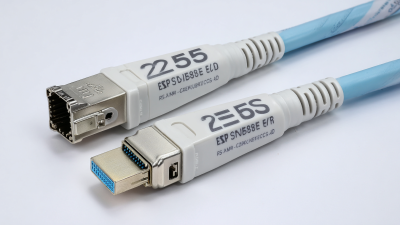Leave Your Message
In today's rapidly evolving digital landscape, the demand for high-capacity networks is greater than ever, driven by the exponential growth of data traffic. According to a report by Cisco, global IP traffic is expected to reach 4.8 zettabytes per year by 2022, translating to a staggering growth rate of 26% annually. To address this surge, networking solutions must not only be robust but also efficient and scalable.

The Cisco DWDM SFP+ (Dense Wavelength Division Multiplexing Small Form-factor Pluggable) emerges as a vital component for modern high-capacity networks, enabling service providers to utilize existing infrastructure while significantly increasing bandwidth. This technology allows for multiple wavelengths of light to travel down a single fiber, effectively maximizing its use and ensuring optimized performance. In a climate where every bit of capacity matters, leveraging Cisco DWDM SFP+ technology is essential for businesses looking to future-proof their networking capabilities and accommodate increasing data demands.
Dense Wavelength Division Multiplexing (DWDM) technology has become a cornerstone for modern high-capacity networks, as it enables the simultaneous transmission of multiple data streams over a single optical fiber. According to a report by the International Data Corporation (IDC), the global DWDM market is projected to reach $6.29 billion by 2025, reflecting a compound annual growth rate (CAGR) of 15.2% from 2020. This growth underscores the increasing demand for bandwidth, spurred by cloud computing, 5G rollouts, and the rising use of high-definition video streaming.
DWDM technology operates by dividing the light spectrum into multiple channels, each carrying its own data signal. This allows for a significant increase in the capacity of fiber optic networks while reducing infrastructure costs. In a study published by the Telecommunications Industry Association (TIA), it was highlighted that DWDM can support data rates of up to 400 Gbps on a single wavelength, providing the scalability needed for future-proofing network infrastructures. Thus, utilizing Cisco DWDM SFP modules ensures compatibility and reliability within existing systems, making them an essential choice for network operators.
**Tips:** When integrating DWDM technology, consider starting with a pilot project to evaluate performance metrics and ensure seamless operation. Additionally, keep an eye on future technology advancements, such as elastic optical networking, which could further enhance DWDM efficiencies. Lastly, invest in training for your technical staff to optimize the deployment and ongoing management of DWDM solutions.
| Feature | Description | Importance |
|---|---|---|
| High Capacity | Supports multi-channel data transmission | Crucial for handling increasing data traffic |
| Cost-Effectiveness | Reduces infrastructure costs by utilizing existing fiber | Helps enterprises manage budget while upgrading networks |
| Scalability | Easily integrates additional channels as needed | Allows networks to grow without major overhauls |
| Enhanced Performance | Provides low latency and high reliability | Essential for applications requiring real-time data processing |
| Flexibility | Supports various transmission formats and protocols | Adapts to diverse network environments and needs |
Cisco DWDM SFP (Dense Wavelength Division Multiplexing Small Form-Factor Pluggable) modules have revolutionized high-capacity networking environments by delivering a range of key benefits that align with the growing demands of data traffic. According to the latest report from the Dell’Oro Group, the global optical transport market is projected to grow at a CAGR of 6% from 2022 to 2027. This shift emphasizes the need for efficient bandwidth utilization, which is precisely where Cisco's DWDM SFP modules excel. By allowing multiple data streams to coexist over a single fiber, these modules significantly increase the data transmission capacity without the need for costly infrastructure upgrades.
Moreover, Cisco DWDM SFP modules enhance network scalability and flexibility, which are critical in today’s data-driven landscape. A report from Research and Markets highlighted that the demand for cloud-based services and large-scale data centers is expected to surge, pushing the requirement for more robust optical solutions. With a capacity of up to 400G and the ability to support distances over 80 kilometers without signal degradation, Cisco's DWDM SFP modules empower organizations to effectively future-proof their networks, ensuring seamless connectivity in high-capacity scenarios while minimizing latency and maximizing overall performance.
Installing a Cisco DWDM SFP (Dense Wavelength Division Multiplexing Small Form-Factor Pluggable) module is a critical task for network engineers looking to enhance their network capacity and efficiency. The first step is to ensure that all equipment is powered down to prevent any potential damage during installation. With the network planner in mind, the engineer should identify the appropriate SFP slot on the switch or router that will accommodate the new module. Care should be taken to handle the SFP module by its edges to avoid contaminating the optical connectors.
Once the suitable slot is located, the engineer can gently insert the DWDM SFP, ensuring it clicks securely into place. After installation, the next step involves powering up the equipment and verifying the module recognition through the network interface. This may include accessing command-line tools or graphical user interfaces to confirm that the DWDM SFP has been successfully integrated into the network system. Regular monitoring and testing of the fiber links are also advisable to guarantee optimal performance and address any connectivity issues promptly. This systematic approach ensures a seamless transition to higher capacity networks, reinforcing the reliability of modern infrastructures.

Integrating Cisco DWDM SFP modules into existing infrastructure can significantly enhance network performance and capacity. When implementing these modules, it’s crucial to assess your current network configuration. Ensure compatibility with existing optical components to avoid disruptions. Conducting a thorough network assessment helps identify necessary upgrades and adjustments required for seamless integration.
**Tip:** Before installation, perform a compatibility check with your existing routers and switches. This step will minimize the risk of operational issues and ensure that your network can handle the increased bandwidth provided by the DWDM SFPs.
Once compatibility is confirmed, focus on proper installation and configuration. Utilize network monitoring tools to observe the impact of the new SFPs on overall performance. Adjust power levels and signal parameters as needed to optimize data flow and maintain signal integrity.
**Tip:** Regularly schedule maintenance checks to monitor the performance of your DWDM modules. Stay proactive in addressing any potential issues that may arise, ensuring your high-capacity network continues to function efficiently.

When managing modern high-capacity networks, troubleshooting issues with Cisco DWDM SFP (Dense Wavelength Division Multiplexing Small Form-factor Pluggable) modules is crucial for maintaining optimal performance and reliability. One common issue network operators face is the failure of signal transmission. This can often be traced back to issues such as improper installation, module compatibility, and faulty connectors. Ensuring that SFP modules are correctly seated and that the optical fibers are clean and free of obstructions can significantly mitigate these problems.
Another frequent concern is the monitoring of optical power levels, as deviations can indicate potential hardware failure or degradation in performance. Utilizing network management tools to keep track of these parameters can help identify issues before they escalate. Additionally, checking for environmental factors such as excessive temperature or humidity is essential, as these can adversely affect the functioning of DWDM SFP modules. By proactively addressing these common troubleshooting scenarios, network operators can ensure the seamless operation of their high-capacity networks.






